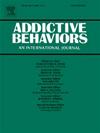青少年开始吸烟的时间与不良健康后果的关系
IF 3.7
2区 医学
Q1 PSYCHOLOGY, CLINICAL
引用次数: 0
摘要
背景电子烟(电子烟)是美国青少年最常用的烟草产品。本研究调查了当前青少年电子烟使用者开始使用电子烟的时间。方法数据来自2019-2022年全国青少年烟草调查,研究样本包括在过去30天内报告使用电子烟≥1天的青少年(n = 9,424)。开始使用电子烟的时间是用当前年龄减去首次使用电子烟的年龄计算得出的,然后分为< 1年、1年、2年和≥3年。结果目前电子烟使用者中使用电子烟时间为 1 年的比例从 2019 年的 29.6% 下降到 2022 年的 13.2%,而使用电子烟时间≥ 3 年的比例从 16.5% 上升到 46.0%(p <0.0001)。开始吸烟时间≥3 年的比例在不同人口群体中都有所上升。开始吸烟时间越长(≥3 年 vs. < 3 年),戒烟意向的几率越低(AOR=0.6[0.4-0.8],p = 0.0003),频繁使用电子烟的几率越高(AOR=3.0[2.3-4.0],p < 0.0001)、双重使用电子烟和其他烟草制品(AOR=1.7[1.3-2.3],p = 0.0005)、烟草渴求(AOR=2.2[1.5-3.1],p < 0.0001)、烟草依赖(AOR=1.9[1.2-3.0],p = 0.004)和存在认知障碍(AOR=1.3[1.04-1.73],p = 0.03)。结论本研究的结果强调,需要采取全面的公共卫生措施、可及的戒烟计划和有效的烟草控制政策,以遏制早期长期使用电子烟。本文章由计算机程序翻译,如有差异,请以英文原文为准。
Time since initiation on current vaping among adolescents and associations with adverse health outcomes
Background
Electronic cigarettes (e-cigarettes) are the most commonly used tobacco products among U.S. youth. This study examined time since initiation among current adolescent e-cigarette users.
Methods
Data were drawn from the 2019–2022 National Youth Tobacco Survey, and the study sample included adolescents who reported ≥ 1 day of e-cigarette use in the past 30 days (n = 9,424). Time since initiation was calculated by subtracting the age of first e-cigarette use from the current age, then classified as < 1 year, 1 year, 2 years, and ≥ 3 years. Logistics regressions were performed to examine the change in time since initiation (≥3 years vs. < 3 years) from 2019 to 2022 and associations of time since initiation with tobacco use and adverse health outcomes.
Results
The proportion of current e-cigarette users with time since initiation < 1 year decreased from 29.6 % in 2019 to 13.2 % in 2022, while the proportion of those with time since initiation ≥ 3 years increased from 16.5 % to 46.0 % (p < 0.0001). The increases in time since initiation ≥ 3 years were observed across demographic groups. Longer time since initiation (≥3 years vs. < 3 years) was associated with lower odds of vaping quit intention (AOR=0.6[0.4–0.8],p = 0.0003) and higher odds of frequent e-cigarette use (AOR=3.0[2.3–4.0],p < 0.0001), dual use of e-cigarettes and other tobacco products (AOR=1.7[1.3–2.3],p = 0.0005), tobacco craving (AOR=2.2[1.5–3.1],p < 0.0001), tobacco dependence (AOR=1.9[1.2–3.0],p = 0.004) and the presence of cognitive impairment (AOR=1.3[1.04–1.73],p = 0.03)
Conclusions
The findings of this study underscore the need for comprehensive public health initiatives, accessible cessation programs, and effective tobacco control policies to curb prolonged e-cigarette use in early life.
求助全文
通过发布文献求助,成功后即可免费获取论文全文。
去求助
来源期刊

Addictive behaviors
医学-药物滥用
CiteScore
8.40
自引率
4.50%
发文量
283
审稿时长
46 days
期刊介绍:
Addictive Behaviors is an international peer-reviewed journal publishing high quality human research on addictive behaviors and disorders since 1975. The journal accepts submissions of full-length papers and short communications on substance-related addictions such as the abuse of alcohol, drugs and nicotine, and behavioral addictions involving gambling and technology. We primarily publish behavioral and psychosocial research but our articles span the fields of psychology, sociology, psychiatry, epidemiology, social policy, medicine, pharmacology and neuroscience. While theoretical orientations are diverse, the emphasis of the journal is primarily empirical. That is, sound experimental design combined with valid, reliable assessment and evaluation procedures are a requisite for acceptance. However, innovative and empirically oriented case studies that might encourage new lines of inquiry are accepted as well. Studies that clearly contribute to current knowledge of etiology, prevention, social policy or treatment are given priority. Scholarly commentaries on topical issues, systematic reviews, and mini reviews are encouraged. We especially welcome multimedia papers that incorporate video or audio components to better display methodology or findings.
Studies can also be submitted to Addictive Behaviors? companion title, the open access journal Addictive Behaviors Reports, which has a particular interest in ''non-traditional'', innovative and empirically-oriented research such as negative/null data papers, replication studies, case reports on novel treatments, and cross-cultural research.
 求助内容:
求助内容: 应助结果提醒方式:
应助结果提醒方式:


